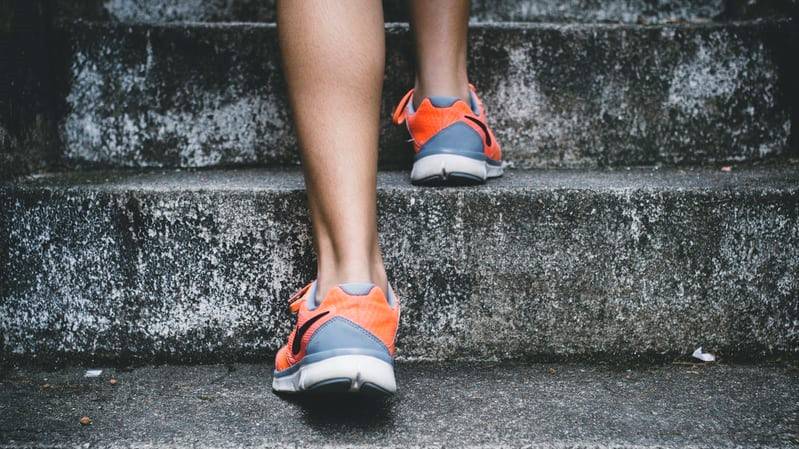Obwohl die häufigsten Verletzungen beim Triathlon wahrscheinlich Überlastungsschäden sind, kann es auch hier zu anderweitigen Verletzungen kommen. Eine der im Sport am häufigsten auftretende Schädigung ist der Bänderriss im Sprunggelenk. Obwohl dieser häufig bei Kontaktsportarten zu finden ist, kommt er auch im Triathlon immer wieder vor, da bereits ungünstiges Auftreten zur Verletzung führen kann.
Anatomie
Die Bänder sind die Verbindung zwischen Fuß und Unterschenkel und sind ein stützendes und flexibles Element des Sprunggelenks. Gerade hier sind die Außenbänder besonders anfällig und bereits normales Umknicken kann zu Zerrungen, Überdehnung oder Rissen führen. Die Innenbänder sind eher seltener betroffen.
Ursachen
Bei Sprungsportarten wie Basketball, Handball und Volleyball führt häufig eine unkontrollierte Landung zum Riss. Dabei knickt der Fuß unter hoher Belastung um, was von den Bändern nicht mehr verhindert werden kann. Im Triathlon ist das unglückliche Umknicken auch oft eine Ursache, teilweise sind die Verletzungen aber auch selbst verschuldet. Durch schlechtes Aufwärmen, laufen auf schlechtem, nassem oder unübersichtlichem Terrain, unpassende Schuhe oder zu intensives Training bei Ermüdungen sind häufige Auslöser, aber eben auch vermeidbar. Deswegen achtet beim Training immer darauf, dass ihr nicht wegen Unachtsamkeit oder Faulheit eine Verletzung in Kauf nehmen müsst. Auch in den Wechselzonen, beim Schwimmausstieg oder beim hektischen auf- und absteigen vom Rad ist man mit dem Kopf oft woanders als beim sauberen Laufstil, aber gerade hier ist es wichtig aufmerksam zu sein, da ein Ausscheiden aus dem Wettkampf aufgrund vermeidbarer Verletzung sehr ärgerlich wäre.
Erstbehandlung und Diagnose
Falls ihr doch umknicken solltet, könnt ihr euch an die PECH-Regel halten. Das steht für
pausieren, Eis zur Kühlung an das Gelenk halten, Compression und Hochlegen. Der Schmerz- und Schwellungsgrad zeigen an, ob ein Besuch beim Arzt notwendig ist. Dort wird meist mit Hilfe eines Beweglichkeitstest (z.B. Schubladentest) zwischen Bruch, Riss und Zerrung unterschieden. Auch ein Röntgenbild kann einen Bruch ausschließen, aber hierbei greifen manche Ärzte noch auf eine gehaltene Aufnahme zurück, bei der der Fuß in eine Spannvorrichtung gelegt wird um den Gelenkspaltwinkel zu messen. Bei dieser Methode kann es zu weiteren Schädigungen des Gewebes kommen und ein kompetenter Arzt sollte einen Riss auch ohne Röntgenaufnahme feststellen können.
Bänderriss - Behandlung
Im Sprunggelenk gibt es drei Bänder bei denen das vorderste am ehesten und das hintere am unwahrscheinlichsten reißt. Auch die Kapsel des Gelenks kann durch Risse betroffen sein, was zur der klassischen Schwellung und Verfärbung führt. Anrisse sind beispielsweise durch die vorhin genannte gehaltene Aufnahme auch nicht feststellbar. Ein Gips ist beim Bänderriss nur selten nötig, da sich eine Schiene/Orthese besser für Beweglichkeit und die gleichzeitige Stützung des Gelenks eignet. Auch die Muskelatrophie ist bei der Schiene geringer. Eine Operation ist nur bei wirklich schweren Traumata oder chronischen Instabilität des Gelenks nötig. Die Ruhezeit beträgt um die 6 Wochen.
Trainingseinstieg
Unter Ruhezeit sollte man aber nicht (nur) ausschließliches hochlegen des Fußes verstehen. Sobald die Schwellung zurückgegangen ist, kann mit leichter Bewegung begonnen werden, damit die Muskulatur nicht verkümmert. Bei Bewegung sollte aber die Stabilität des Gelenks sicher gestellt sein und leichte Kräftigungsübungen, gehen und Radfahren sind auch in Ordnung. Auch die Physiotherapie ist sehr empfehlenswert (auch wenn sie teils selbst finanziert werden muss). Eine gute Heilung und die Wiederherstellung und Verbesserung der Gelenkstabilität sind nämlich essentiell für die weitere Sportkarriere, da es ohne kontinuierliches Training zu chronischer Instabilität kommen kann. Auf die 6 Heilungswochen sollten dann ca. 6 Wochen des Aufbautrainings folgen, da sich die Gelenke erst wieder an die Triathlon-Belastung gewöhnen müssen. Leichte Schmerzen zu Beginn des Trainings sind leider normal (bei stärkeren Schmerzen sollte das Training aber reduziert oder pausiert werden und noch einmal ein Physiotherapeut aufgesucht werden), vor allem beim Beinschlag und beim Ziehen an der Radkurbel. Der Trainingsumfang und die -intensität sollten erstmal langsam und unter Absprache mit einem Arzt oder Physiotherapeuten gesteigert werden.
Prophylaxe
Da nach einer Verletzung die Gelenke und Bänder erst sehr langsam (wenn überhaupt) auf das anfängliche Niveau zurückkehren, sollte man darauf achten, das Risiko für erneute Verletzungen so stark wie möglich zu reduzieren. Dafür hilft es, für jeden Lauf das passende Schuhwerk zu verwenden, sich gründlich aufzuwärmen, Ermüdung ernst nehmen und nicht überbeanspruchen und die Gelenke und umliegende Muskulatur zu festigen. Im Vordergrund sollte dabei die Kräftigung der Schienbeinmuskulatur und die Dehnung der Wadenmuskulatur stehen, aber auch propriozeptives Training ist wichtig. Dabei wird durch koordinative Übungen auf dem Wackelbrett, der Slackline oder dem Therapiekreisel die intra- und intermuskuläre Koordination gestärkt, was zu einer besseren Zusammenarbeit und schnelleren Reaktionsfähigkeit der Muskulatur führt. Barfußlaufen hat übrigens ähnliche Effekte.
Übungen zur Kräftigung des Sprunggelenks
Zehenstand: Abwechselnd auf die Zehenspitzen stellen und wieder ablassen, oder oben halten. Die Durchführung auf unebenem Untergrund verstärkt die Koordination.
Wechselschritt: Abwechselnd auf Zehen und Hacke stellen.
Storchenschritt: Lange und langsame Schritte machen und dabei kräftig mit den Zehenspitzen abstoßen und gezielt auf ihnen landen.
Schienbeinmuskulatur: Fußspitzen gegen Widerstand von Theraband oder Partner nach oben ziehen.
Hüpfen: Beid- oder Einbeinig möglich, aber nur bei fortgeschrittener Genesung.
Lauf-ABC: Alle Übungen sind hier sinnvoll. Sprungübungen aber nur nach Verheilung der Verletzung durchführen. Fuß-ABC: Abwechselnd auf Zehen, Außenkante, Innenkante oder auf der Hacke laufen




















